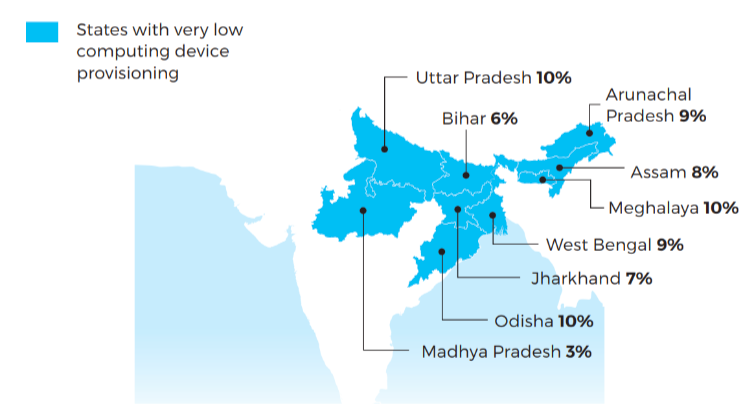Missing Teachers, Lack of Technology -- India’s Education System Plagued with Problems: UNESCO Report
New Delhi: Only 22.3% of schools across the country, government and private, had internet facilities in 2019-20, a year when education went online following the COVID-19 induced lockdown, says a new report, pointing out gaping holes in the schooling system in India.
The report, titled ‘No Teacher, No Class’, is the third edition of United Nations Educational, Scientific and Cultural Organisation's (UNESCO) State of Education Report for India 2021, was published earlier this week, and focuses on teachers. It highlights the ground reality “to inform and enhance the current and future programmes and policies aimed at the overall development of teachers in India.”
According to the report, the state of schooling in India is in urgent need of betterment. During the past year, when school education went completely online due to the pandemic, a sizeable section of students did not have access to the means to learn through virtual education, and neither did a lot of schools.
Earlier this year, the Education Ministry’s report on Unified District Information System for Education Plus (UDISE+) also highlighted that only 22.3% of schools across the country, government and private, had internet facilities in 2019-20, a year when education went online following the COVID-19 induced lockdown.
The UNESCO report cited similar numbers, saying that only 26% of schools have internet availability. It said, “The overall availability of computing devices (desktops or laptops) in schools is 22% for all India, with rural areas seeing much lower provisioning (18%) than urban areas (43%). Access to the internet in schools is 19% all over India – only 14% in rural areas compared to 42% in urban areas.

According to the report, 30% of teachers work in the private unaided sector and about 50% in the government sector. The report pointed out that while teacher availability has improved over the years, the pupil-teacher ratios are adverse in secondary schools. There is no information on the availability of special education, music, arts and physical education teachers.
The extent of availability and deployment of subject teachers is also not known. Almost all single-teacher schools are in rural areas. The North Eastern states of India need special efforts to improve the availability of qualified teachers and deployment, the report suggested.
“Working conditions of teachers in the northeast and the aspirational districts are poor from the point of view of basic amenities. Provision of school libraries is low, ICT infrastructure is very low, and there is marked rural-urban disparity,’ it said.
According to UNESCO, “The profession is overall gender-balanced at about 50% women. But some sectors – early childhood, special education and private unaided schools – are highly feminized. This may have to do with lower salaries, rendering teaching jobs as second incomes to be taken up by women. It is noticed that states high in PGI are also states with a high proportion of women teachers.”
The report pointed out that in about 15 years, 27% of the current workforce would need to be replaced. The workforce has a deficit of over one million teachers (at current student strength), and is likely to need to grow overall given the shortages of teachers in certain education levels and subjects such as early childhood education, special education, physical education, music, arts, and curricular streams of vocational education.
The report points out that increasing urgency to improve quality, accountability, and governance is required in the education sector. There were 9.7 million teachers in 2019-20. The private, unaided sector accounts for 30% while the government sector employs about 50%.
The pupil-teacher ratios are alarming in secondary schools. Around 1.1 lakh schools have just one teacher, and almost all such schools are in rural areas. About 19%, that is, 11.16 lakh teachers’ positions in schools are vacant, and 69% of them are rural areas.
Using data from UDISE, the report profiles the current teaching workforce and reveals aspects of teacher availability, deployment, and working conditions.
This report attempts to provide an understanding of key aspects of the teaching profession and workforce in India—nearly 9.7 million teachers in 2019/20—the complex work that they do, and their professional development, through the filters of policy debates, choices, pushes and pulls. It looks at the questions that create core tensions in the sector and affect teacher quality and availability.
The report's analytical framework draws from important contextual and sectoral aspects, including India’s social and political context—especially its federal structure—and social characteristics of gender, caste, rural-urban divide, and the government-private divide.
UNESCO also pointed out that a large proportion of teacher education programmes in India run in ‘self-financed’ colleges. Their geographic spread across the country is uneven. There are very few programmes that prepare teachers of special education, vocational education, arts and music. While admissions in B.Ed. programmes seem to be stable, D.El.Ed and M.Ed. admissions are currently shrinking. Some states see lower admission of students from science backgrounds in the absence of state-regulated admission processes.
The organisation made several recommendations to improve the situation in India. It is said that many teachers, whether in private or in government schools, are not compensated fairly and suffer from poor working conditions. A significant number of teachers work with short contracts, mostly without corresponding statutory benefits, and receive low salaries as compared with regular teachers. It emphasised that the terms of employment of teachers in both public and private schools should be improved.
It also highlighted an urgent need to increase the number of teachers and improve working conditions in north-eastern states, rural areas, and aspirational districts. It said, “Special attention needs to be paid to rural areas, districts with high scheduled caste and tribe populations, and all across India's north-east, where the ratio of teachers to students needs to improve and be rationalized. Working conditions in these ‘difficult to staff’ regions also need to be improved, including basic amenities, better provisioning of libraries, and access to information and communications technology (ICT). More state support for teacher education programmes is desirable in these regions.”
The other recommendations made by UNESCO include recognition of teachers as frontline workers, respect for their autonomy, and restructuring pre-service professional development. It also added, “Teachers must develop pedagogical content knowledge as well as a critical understanding of social context and the aims of education. The pre-service teacher education curriculum must provide new entrants with deeper knowledge and understanding of pedagogy that enables them to teach differently from how they learnt. Teaching standards should be used to inform and shape professional development rather than for performance measurement and appraisal. Diverse educational pathways into the profession are desirable to develop a diverse and motivated teaching workforce"
Get the latest reports & analysis with people's perspective on Protests, movements & deep analytical videos, discussions of the current affairs in your Telegram app. Subscribe to NewsClick's Telegram channel & get Real-Time updates on stories, as they get published on our website.
























